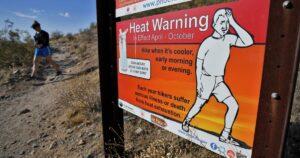
I’m sure I don’t have to tell you…it’s been a hot summer so far. Obnoxiously hot. And while there’s not a ton that our city can do to alleviate that, it is not entirely powerless. That said, it’s fallen behind some of its neighbors in its efforts to mitigate the urban heat effect. So why is that?
First of all, there are two main factors when it comes to helping mitigate heat in a sun-soaked area like the Valley: the amount of asphalt and the number of trees. And while everyone agrees to the aesthetic and functional importance of the latter, the first item has become the flashpoint of controversy.
First were the findings of a recent study outlined in the above article; it gave a stark picture. As far as the city went, south Scottsdale had the least number of trees at 6% – less than half the citywide average. And 48% of the southern part of the city is covered by asphalt, nearly three times the citywide average of 17%. With 35% covered by asphalt, Old Town was double the city average. So our most tourist-friendly area is the least friendly to reasonable temperatures, a fact which is likely to hurt tourism if temperatures continue to increase over the decades.
And this is where the controversial “road diet” plan came into play. As part of the city’s sustainability plan, planners tied the increased shade and decreased asphalt to the plan for fewer driving lanes, i.e. the “road diet”. That plan got immediate pushback as something that ran anathema to our area’s ethos, one that is driver friendly first and walkable second. Planners made the mistake of linking something that we all could agree with with something that few of us would buy into.
It is safe to say that even the most ardent, small government conservative is probably going to feel fairly positively about trees being planted in Scottsdale. Anyone who has spent as much as a few summer days here understands the importance of shade, and everyone appreciates the aesthetics of trees, especially as compared to asphalt. But we will always be a driving-centric area, and while decreasing the amount of asphalt would certainly decrease the urban heat island effect, that is a bridge too far for your average Arizonan.
In an ideal world we would have less asphalt, yes. But linking tree shade to decreasing drivability in our city is a losing proposition where the baby gets thrown out with the bathwater and nothing happens. We hope that the city comes back with a pared down proposition that aggressively focuses on tree planting and avoids the controversy of negatively impacting drivers. We are who we are, and that won’t change anytime soon.

